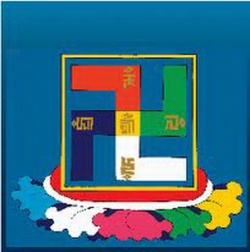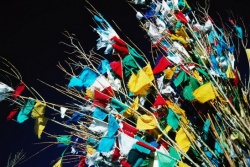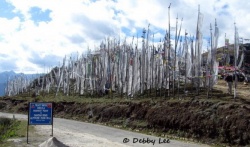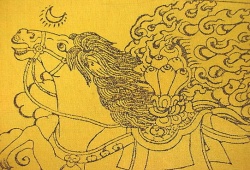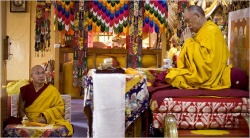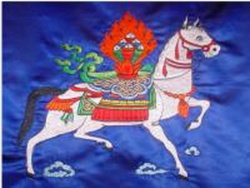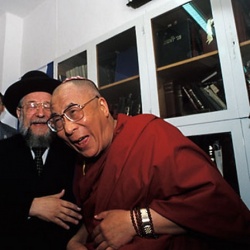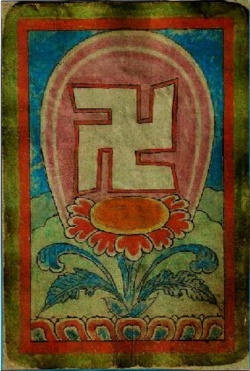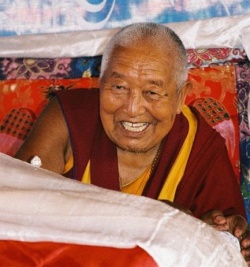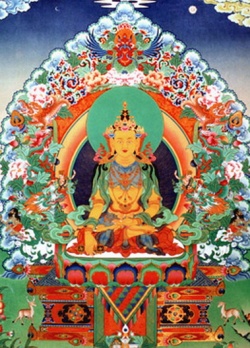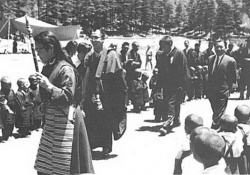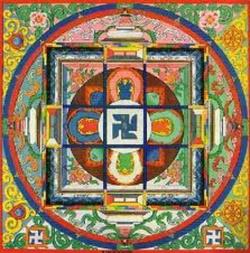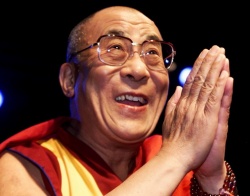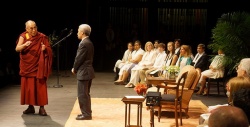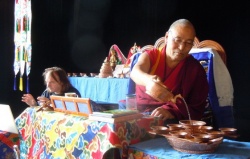Short Tibetan History
Tibetan History begins with the incursions of Tibetan K'iang in Central China when Buddha was living in India, Confucius and Lao-tseu in China (5th century B.C.). The History of Tibet can be
divided in two parts = the first one with the establishment and the end of the Tibetan Kingdoms, the second with the establishment and the end of the Dalai-Lama Theocracy. During both periods civil and religious
problems are mixed and cannot be made distinct. In the seventh century, the Tibetan King Sron-tsan-gampo was very powerful and a menace to the Chinese Empire. During this period, many famous buildings and holy places were built.
Later when the Tibetan leadership in Central Asia was weaker, the Mongol Khan considered Tibet as a sacred country and secured it. This protection continued when Mongol Dynasty reigned over
China. The Chinese Ming Emperors also acknowledged the leadership of Tibetan Buddhism in all of China. Tibet lived peacefully up to the recent period. The first European travellers to visit
Tibet were very impressed by the country and its inhabitants. They reported that Tibet was considered as a mythic country. At the end of the second World War, the Mao-Tse-tung Army defeated Chang-Kai-chek and invaded peacefull Tibet.
After installation of a pro-Chinese Administration, the first decisions brought a severe famine, suppressed civil rights and imposed the Chinese language. In March 1959, Lhasa population obliged the Dalai-Lama to escape in
India, against his will... In the 1970's, during the Cultural Revolution the Red Guards destroyed nearly 2000 official buildings and holy places, and burnt nearly all the Tibetan libraries and books to get rid of the Tibetan civilisation and language.
For the last 4 years a strong repression has occured in Monasteries, in spite of the presence of Europeans journalists and tourists. The actual facts don't seem sufficiently interesting for the Western media.............
More extensive view on the history below.
Badly known history of Tibet
by Cl.André
ex-lecturer at the Paris' Oriental College
Nice on 14 June 1998
The history of Tibet can be divided in two parts :the first one is the establishment and the fall of royalty which will last all of the first millenium, the second one sees the establishment and the fall of theocracy during the second millennium. We will realize that during these two periods, the religious and laic facts are narrowly mixed.
History cannot be approached without noting the general aspect of the country and of its inhabitants. Average altitudes range between 4 and 5000m. Tibet represents about a quarter of the Chinese territory and 1/500th of its population. It is thus a country with extreme living conditions and a low inhabited density. The country
occupies the site of the sea of Thetis, which separated the old Asiatic and Australian continents. The displacement of the tectonic plates broke up the Australian plate in three parts = the northern which formed India was detached
and in a rapid displacement towards the north raised the sediments of the sea of Thetis which currently forms the relief of the tibetan highlands and the Himalayas.
The central one formed the current Australian continent and the southern one, the Antarctic continent. If, in the shock, basalts and hard stones formed the solid mass of the Himalayas, the sediments which form the tibetan highlands are not consolidated and the relief is in constant erosion. Part of the country does
not have a outlet with the sea, thus creating large considerable salt lakes and stocks of salt are used as a basis for foreign trade. The largest rivers of India and China, take their headwaters there and these rivers all
carry considerable amounts of alluvia. Water runs reddish. In all China' center, air is polluted by a fine dust blowing from the west. In Tibet, a mask is worn to cross the highlands in the summer.
The silt contributed to the richness of the surrounding countries. It should be noted that all ancient civilizations were born in the same way = indeed, whereas the banks of the rivers were not stabilized by men,
rivers were covered each year with vast quantities of silt, and consequently agriculture did not require any effort = seeds were sown, livestock trod the soil and one merely awaited harvest time. The men, relieved of all
agricultural work, were available to build Palaces and to form armies allways ready to make war. The
same process worked as well for the Indus (Mohan-Jo-Daro), the Yellow River, the Yangtse, the Nile and the Mesopotamia.
These rivers nourishing the people are venerated in India since antiquity. Mount Kailas is on the south-west of Tibet, from where the 4 largest rivers of India take their source. Each year, thousands of pilgrims
make their way there.
==Tibet during antiquity==
Tibet seemed ignored during antiquity. Was it enough to go up the rivers to penetrate there? In fact, to the south, the rivers cross mountains where the sides are so steep as to be impracticable. Any narrow path
allowing the passage of a sinle man, will be washed away with the first rains and will make the next passage more difficult. From the east of Tibet, to reach China, it is necessary to cross nearly 2000km of desert in the
north and iced wooded mountains in the south... Certain places are so inaccessibles that one expects to find there the most hidden tribes of Pygmies in the world.
the yak
Without the yak, which exists nowhere else in the world, the country would be uninhabited. The animal is resistant to extreme cold, -30 or -40°. The nights in winter do not frighten the yak even in high winds. It
provides everything = meat, milk of which one makes butter and oil for lamps, the long hair is useful for making ropes, clothing, blanquets and tents, dung is used as fuel, to boil the tea as it does not give enough calories to heat
either a house or a tent. The yak is useful as a pack animal, sure footed in mountainous regions. The soil remains cold between 6 to 8 months of the year and there are no trees visible there. No tree, no coal,
means no heating during winter and not burying of their dead. What people would accept such a way of life? The one consolation is the climate which is very healthy, sky is very blue, almost without clouds, except for the few passages of the Monsoon crossing the Himalayas during the 3 summer months.
==A population of nomads==
A population of nomads was thus disseminated over this immense territory. They raised horses, sold previously to the Chinese army but to this day to the peasants in the valleys. They built villages and castles, traced
roads, standardized customs and language. Later they increased the number of monasteries and religious sites. Tibetans are merry, courageous, always in activity, and if the monastery, the house, and the fields are running
well, they meet under their white tents in a common along the river=men play dominoes or other games, or recite epic poems, drink a slightly alcoholized barley alcohol, called "chang", and the women
form circles nearby, and sing. They regularly carry out pilgrimages on the holy sites which can be lakes, mountains, or distant monasteries. The inhabitants of the valleys, of equal wealth, will be more
refined than the peasants of Europe. There will often be a small library, an oratory, jewels, decorated pieces of furniture, etc...
Compared with our overworked brains saturated with information, the brain of the men of the highlands look like a blank page. Therefore one often meets people looking very poor, but able to tell legends such as
Gesar's, which includes more than one hundred thousand verses. To sing the verses continuously takes days and no one man knows the complete text. It is one of their rare disversions apart from games and archery practised on galopping horses.
position of the woman
The position of the woman is significant. She will often be the head of the family and the equal of man. Thus, under a same roof, in order not to divide the property, a woman may have several husbands and vice-versa. When monasteries were absorbing more than 10% of the population, the women traded in towns.
The houses look like small square blocks made of agglomerated packed earth or stones with a terrace. Rooms open to an interior court. On the roof, " lungta " or wind horses disperse the prayers in the wind, and on the entrance gate a griming god chases away the evils.
In the interior valleys of Tibet, the rivers are carrying much silt usefull for cultivation once the ground thaws out. Wisely they cultivate barley which requires only three months to produce. The grain is stored in silos
made of stones which will be useful for the years of food shortage. The dry and cool climate allows a near-eternal preservation. Travellers have noted here and there stocks adequate for several decades, possibly for more than a century.
The roasted barley, mixed with the tea and butter, rancid or not, will be used as a basis for the nourishment = it is the " tsampa ". This country does not practise any traditional good cooking. However, in the lowest valleys
of the south and south-east, one will find trees and vegetables as in our countries. These products, forwarded
to Lhassa, were consumed previously by the rich families, who practised a cooking inspired from China or India. Today these products, inter alia, are used in the tourists restaurants.
Finally, hunting was not regarded as an essential activity for the man of the highlands. If there were many forests on mountainsides at the east border of Tibet, working on them was very difficult. Moreover
Tibetans always respected nature and the environment. Hunting or logging was regarded as belittling. Indeed, they always lived in a state of survival, like the savage animals which surrounded them. Blue
skies of an exceptional purity, just as the imposing landscapes, encouraged the inhabitants to respect
nature and wild animals, and to transcend towards a higher ideal the forces which were in their power.
Let us return to the history of the country. We will first look at what happened during the first millenium.
If one believes in the traditions of the previous religion called Bon, man descended from a monkey and a she-devil of the rocks who lived in the valley of Yarlung. Just where the young monkeys played in this valley,
one of these villages is called Tsethang or " plain of the games ". It is today one of the most important cities of Tibet. Recently, one found traces of life and Neolithic vestiges of villages in Central Tibet
= some excavations are located 5km to the north of Lhassa.
Herodotus (towards 350 B.C.) speaks about a country inhabited by gold digging giant ants. Nowadays, the gold washers of the rivers in the north of the Himalayas leave behind them mounds of sand shaped like termitories!! Even in those days, information alters and turns quickly into fantaisy.
The first tibetan incursions in China come with the Kiang' tribes, coming from the arid steppes of the North-East of Tibet, at the time of the Tcheou's, or at the time of Confucius and Lao-tseu, nearly -550 B.C.and will continue for several centuries.
==Buddha==
During that time, in Kapilavastu, in a small State located at the south of current Nepal, was born Prince Siddharta, the future Buddha. I cannot continue without giving a brief description of his life and his doctrine, otherwise the history of Tibet which follows would not make any sense, I apologise
to those who know it already. His parents gave him as adolescent, a life free of vexations (a situation similar to our current Youth). As, an adolescent, disguised as a servant, he came into town and discovered all the miseries of the
world. One evening, he met an old man, a dying man, then a man who had the plague, crying in pain and a corpse covered with blood. He had such a shock, he decided to change his fate. One night, he left the Palace for ever and joined a group of monks who preached fine speeches in town.
He changed sects several times. One preached mercy but the monks benefitted from this to feast with the
takings, an other preached fasting and privations, but that brought nothing positive, neither for the body, nor the spirit. Then he decided to leave and was joined by some friends.
One evening close to Gayae felt the revelation of what he had been seeking for a long time and which has since been called the "Illumination". He sat under a fig tree and decided not to rise until the revelation he was seeking came to him
Indeed, in the world, there are animals, creatures deprived of conscience and thus responsible for their acts, for whom misfortunes in their existence are without explanation. There are individuals deprived of moral who are able to perpetrate the darkest deeds to satisfy their desires. There are others who, although
non-evil, are greedy who work to get rich (and often without success) and finally there are those who like him wish to have an existence where the individual, transgresses his personal case, seeks a healthy life, in
harmony with nature, animals and especially people. Moreover, this moral objective must place the conscience on a level where earthly misfortunes are controlled by the spirit and with no effect on our
minds. Thus the pain and all terrestrial miseries can be dominated. The spirit of conscience will rise to the level of the gods such as imagined at the time = unburdened by human vicissitudes and away from time.
That day, he defined the twelve stages which mark the life of an individual = the discovery of the 5 senses, knowledge, love, founding of a family, getting property, etc. Moreover life is no more than an
uninterrupted succession of births and rebirths. This conscience which is given to us at birth, if it is well used, if is gradually enriched by knowledge, humanism and generosity, it still transcends
mankind towards a level of higher happiness. Thus any action, any word, corresponds to an energy which will be either positive (towards godness or the ideal of man), or negative (as the animal) according to whether we
achieve good or evil deeds. In the same way, our soul will leave an inprint on the spirit of future generations. Thus, it can be said it does not die.
The rules of life are simple. 1- It is to avoid conflicts or any type of aggressiveness. 2-It is necessary to seek knowledge and to try to inform oneself, because the more we have learnt, the closer we will be to the truth. 3- Lastly, it is essential to live simply and avoid any superfluous desire (in particular material).
==After Buddha's death==
When Buddha had defined the distress of men, their causes and how to cure them, he rose and joined his disciples near Benares. Buddhism spread to all Asia. This religion, or thinking, without any
precise dogma, nor prohibited sectarism, was little encouraged centuries later when new conflicts rose in North-India. Hindouism and vindication of warlike gods drove out the Buddhist idea towards the north in Tibet, China and Japan, and towards South-East Asia.
After Buddha's death, steles, stupas and monuments were built wherever Buddha had preached and his disciples met one year after his death in Rajagrha, capital of Maghada, in order to write the
buddhist holy canon = this is divided into 3 "parts" = Vinaya (the discipline), Sutras (sayings of the Buddha) and Abbidharma (or metaphysics). It was then gradually established that other Buddhas, Tathagathas (4 or 7) had preceded him, and one defines the statute of Boddhisatvas.
==future Buddhas==
Who are these Boddhisatvas? In fact future Buddhas who, before deliverance, remained halfway, and they were given as mission, helping men to reduce the number of rebirths in order to reach a quicker
deliverance. They are the ones who will receive our prayers. When the image of a Buddha is stared at, there is no communication, because he is outside this world; on the other hand, if one stares at a
Boddhisatva, this one may transmit to us this strenght we are seeking from him. This is why the Dalai-lama who represents a Boddhisatva will be more venerated (aktet) than the Panchen-Lama who represents only one Buddha.
In -250 B.C., a school put forth the assumption that the Buddha and his likenesses, could only be producted outside any concrete existence. Then, within the Indian University of Nalanda, a legendary man, Nagarjuna founded
the school of Madhamika (or average path) which obtained a deep importance in the diffudion of Buddhism in Tibet and in China. In holy texts, there were the 10 capital sins, the 10 virtues, and
among them 6 are transcendantales or " paramitas ". He multiplied texts named Prajnaparamitas or "transcendantal extreme intelligence" which develops the doctrines of the vacuity, or void through texts full of
meaningless expressions, but whose reading brings us closer to the deliverance. The concept of void takes form. "
Tantrism " is a form of Buddhism which followed from there, copying the symbol of the couple Shiva-Kali, and introducing female demonstrations (dakkinis, yoginis, etc) into the Buddhist Pantheon. This new
form of Buddhism is called Mahayana whereas it's primitive form that one meets in South-East Asia (Thailand, Burma, Kampuchea, etc) is named Hinayana. I will return to the subject later.
The first texts of Mahayana arrived in China around 65 years A.D. Many Chinese travellers, Fa-hien, Hiuan-tsang, etc. came in Maghada to obtain texts. Which road did they follow? The road of silk, the one
which crosses the Himalayas in the solid mass of Karakorum, the road recently used by Citroen expedition. They speak little about Tibet, yet the Buddhist texts spoke of the holy lake of Anavatapta
from where spout out the four large holy rivers of India and in the north of this lake, of a giant tree whose top (sap) is transformed into gold sheets and touches the sky. One recognizes the lake Manasarovar and the Mt Kailas about which I have already spoken.
One knew little of the history of Tibet during the first millenium until the discovery of a tibetan library in Kansou, on the silk road. It was close to the town of Dun-Houang, ex Cha-tcheou or Touen-Houen, several
strung out hills with caves hollowed out on several levels, called by the Chinese Ts'ien-fo-tong or 1000 caves. Those who have been to China know that the visit of the Buddhist caves always appears on tourist
tours. The upkeep of each cave, whose walls are covered with painted Buddhas, was maintained hereditarily by the members a same family or a same clan. They were maintained until the XIth century. In one of these
caves, a section of wall hid a tibetan library which had hurridly been walled before the arrival of the Chinese armies, first in 839, then definitively in 1035. To Europeans visitors, in about 1900, some
Mongolian shepherds proposed rolls of old manuscripts.
The Britsh Academy, dispatched Sir Aurel Stein who succeeded in bringing back in 1905 several cases of rolls, which are to be found at the India Office in London. In 1908, the Indo-chinese Company of the
Geographic Society of Paris sent M.Paul Pelliot, who had a deeper knowledge of chinese, ouighour, tibetan, Mongolian, brahmi, etc, and was able to select and bring back the most interesting
remaining rolls. Those are currently in the Paris "National Library". These texts confirm the tradition of the first kingdoms in the valley of Yarlung (located at the south-west of Lhasa which flows to the Bramapoutra).
The oldest known castle of Ombulhakang dominates the valley and dates three centuries before our era. A text gives a long list of kings (of 30 generations) before the arrival to the throne of the confederated
Buddhist king Song-tsang-gam-po in 641. The first king of the list, Gnya-khri-tsan-po, came from the dynasty of Licchavi which reigned in Nepal. His father had thrown him in the Ganges and he was
saved by a peasant. His brothers having heard the story, wanted to find and kill him. He then crossed the Himalayas. The sheperds of the area believed him to have dropped from the sky, adored him and made him their king. His eyes
closed upwards like those of the birds. Each time one will spoke of the sovereign, one noted the unatural character and divine link.
The first dynasty includes 7 kings, magicians, non-dead, Nam-la-Khri " who lived in the sky ", they left no traces on earth. They came down from the sky by a cord on one of the holy
tibetan mountains = Bon-ri in Kong-Po, Yarlha-shampo where Yarlung takes its source or Chag-Po-ri, the hill of Potala, rose again in the same way, except for the last = Dri-gum " killed by the sword "who is said to
have died in a brawl in 414. During a drinking bout with friends, he provoked them in duel and one of them accepted the challenge. During the fight, he inadvertendly cut the magic cord " dmu " which connected the king to the skies and he was mortally wounded.
The winner exiled his sons and took his place. It is said that Dri-gum introduced the Buddhism and the new religion was called "Bon ". This one added to the shamanism resulting from the Steppe Empire Area, a new god,
Buddha, as well as the concept of the cycle of rebirths ande delivery. The Bon religion carriedon the magic rituals and masked dances, its emblem was the swatiska (the cross which turns towards the left).
History tells us about the development of irrigation, the planting of trees, the construction of bridges, the use of the yoke and the plough. Numerous descendants will follow E.D.
The next kings developed the use of charcoal, copper' work, iron and coins. The Chinese historians note the excellence of their weapons, their armours and coats of mail??. Later they will reign with Palace Masters and Ministers. There were 17 provinces covering nearly the whole of the
present tibetan influence area. They are spoken of, either by the name of their clan, or by the name of their territory, or by the name of the attributes or animals which decorated their banners.
Generally the kings died young of violent deaths and on several occasions Prime Ministers seized power from the princes.
In the north of Tibet, a new power (history will call it Turkish) had emerged and threatened the west of the Chinese Empire, succeeding old K' iang. They included people of
different origin where the language of a small tribe used to cement them. The Chinese suffered many setbacks but succeeded in dividing them. The Turkish kingdom then divided into two, the Turks of the
West and those of the East. Among those of the East, the Tou-you-en on the borders the Chinese Empire, became their allies. The fact is that they succumbed to the multiple gifts and
Princesses offered by Chinese emperors. This detail will be at the origin of the conflict which arose between Tibet and China.
==VIth century==
Let us return to Tibet. At the beginning of VIth century, the tibetan prince Slon-tsan restored the royal authority on the 17 provinces. He became known as = "Nam-ri" or celestial mountain. It is he who sent
his minister Thonmi-sambhota to India to bring back a system of orthography copied from a Gupta model, (30 consonants and 5 vowels) and a grammar. The first tibetan texts are dated from 655.
Nam-ri died poisoned and the rebellions which followed were repressed in blood. Punishments were severe = hands, nose or feet were cutoff, eyes put out. But the country was very nearly unified. The army
consisted of more than 100.000 men. According to their army corps, the soldiers had a sabre, a bow or a lance. They wore armour and helmet, their head was coloured with red ochre or blood. There were 5 classes of
mandarins or officers = for those of first rank, the badge was of turquoise, for the second rank, of gold, for the third, of gold and silver, for the fourth, of silver and for the
fifth, of copper. Each badge was fixed on a piece of fabric worn on the shoulder. For three centuries, this army will be a constant threat to the Chinese Empire.
At that time the kings were buried in large tumuli. Those of the valley of Yarlung are famous, but there exist others in different valleys in the south of the country. The
largest is more than 120m in length and surmounted by a small temple still being visited. The names of those kings are known. The ceremonial of the funeral described in the texts of Touen-Houang is in conformity
with those previously practised in the past in China = " When the prince dies, his wife, her servants, his friends commit suicide and are buried with him. One also buries his bow,
his sabre, his jewels and the horses which he rode. Above a mound is made and a temple of sacrifice is also built. "
The first great tibetan king and successor to Nam-ri will be Song-tsang-gam-po. He became king at the age of 13. The tradition says that he was threatened by poison and had to escape from several plots. To maintain the unit of Tibet, he spent his life crisscrossing the country with his army.
Song-tsang-gam-po married twice. The first marriage was to the Princess Bri-Tsum, daughter of the
king of Nepal Amçuvarman. Then the king sent an embassy to the Chinese Emperor Tai-tsong, the second of the Tsang dynasty, to claim a Chinese princess, but he met with a refusal.
Tibetans attributed this refusal to the Tou-yu-houen. They invaded and occupied Tou-yu-houen's territory, and invaded China. The Emperor of China had to send three armies to control them. After 7 years of war, not
being able to revict the tibetan armies, the Emperor proposed the Princess Wen-tcheng. According to [[Chinese annals', the tibetan king went to meet his bride and practised the Chinese rites
in Ho-yuan (Kansou). He was overhelmed by the splendour and customs of the Chinese Empire. To express his thanks, he sent his prime minister to present a 7 foot high gold statue weighing 1100 ounces.
==Potala and Lhasa==
A catastrophic flood having destroyed all the villages in the Yarlung valley and having covered the fertile soils with sand, the valley lost its importance. The king then decided to settle in Lhasa and
to build there a new palace known by the name of Potala, or red palace for his Chinese wife. Until the arrival of the 5th Dalai-lama all the kings resided here, but will always be called kings of Yarlung.
Coincidence, this name of Potala was the name of the place, in the south of India, where a saint lived whose name was Avalokitesvara, that very one whose Dalaï lama, 10 centuries later, become the terrestrial representative.
The Nepalese and the Chinese Princesses were devoted Buddhists, zealously competing to build temples and monasteries. They were to be deified later as incarnations of the goddess Tara,
green Tara for Nepalese and white Tara for Chinese. Each one had brought a statue of Buddha in her luggage. In the new town of Lhassa, a large temple was built, the Jokhang, to shelter the
statue of the 12 years old Buddha in solid gold which had arrived with the Chinese Princess. On its arrival in Lhassa, within 200m of the objective, the carriage sank on marshy ground.
Ramoche, another temple, was built on this site. After numerous adventures, the chinese statue joined Jokhang and later, the statue of the Nepalese Princess found its place in the temple of Ramoche. These temples still exist as are the statues.
With these marriages to foreign Princesses, exchanges will develop, ink, paper, tea will come from China, the jewels from India. A Chinese Embassy on its way to Maghada was wiped out while travelling throught
Bihar, in India. The king Song-tsang-gam-po then dispatched an army which destroyed the army of the king of Bihar, captured him and sent him in a cage to his friend the Emperor of
China. The friendship with China ended with Song-tsang-gam-po. His successors take over the territory of the Tou-yu-houen bordering China and the tibetan armies in the year 670 seized all Turkestan from the
Chinese, before penetrating in Setchuan and Yunan where they occupied 18 prefectures. Nepal was also conquered. A new period of peace occurred when Khri-song-lde-tsan married a Chinese princess Kin-tch' eng, but that peace did not last.
Chinese and Tibetans 1300years back
The Chinese sovereigns refused to treat the Tibetans as equals, the Chinese ambassador refusing to bow in front of the tibetan king, Tibetans took up the hostilities again. They even occupied the
Chinese capital Tch'ang-Ngang in 763 and placed there a puppet emperor who reigned briefly. A stele in front of Potala reproduces one of the treaties signed with China favorable to the Tibetans.
Turkestan remain in their power during nearly 2 centuries. The warfare practices were not soft = Tibetans, in one area, killed all young people less than thirty years and as for the others, they cut their hands and tore off
the eyes. Fearing such practices, certain cities fell without resistance. Very often, frontier cities were taken and lost again.
During this period Buddhism was preading in North-East Asia following the traditional road of Karakorum. In Cha-tcheou on the silk road, an important center of calligraphy, that one about which I have
already spoken, translated the Buddhist holy texts from Brahmi or sanskrit into tibetan and chinese.
This center of translation has preserved the oldest Indian documents on Buddhism that have reached us, all types of administrative documents showing how the tibetan country was controlled, as well as the historical accounts recalling the old history of Tibet. Each province had a prefect, one or more chiefs of 10.000, or of 1000 , etc...the
responsibilities were held by Tibetans and each one had an assistant who was a local. There were Ministers or
responsible for water, agriculture, taxes, communications, garisons, etc... Scribes made notes of all decisions, and copies were sent to the king of Tibet, wherever he was.
The tibetan Princes used to be trained, either in the Chinese Schools of Law, or in the Indian Monastic Universities. Returning home, they often brought back, Indian or Chinese monks (or
scientists). From India, a magician originating in Hindhukush Padma-sambava introduced deeper the tantric doctrines of Mahayana. On this occasion, the problem was of implementing the
occult forces (or magic existing rituals) to ensure the deliverance and to avoid the infinite succession of rebirths. One could use the methods of the shamanism, but with new objectives. Padma-sambava
succeeded in modifying the tibetan faith after having triumphed over all the magicians Bon-Po, whom he defeated one after the other. Under his impulse, the large temple of Samye was built in 12 years (towards 775)
taking as model an Indian temple (perhaps that of Nalanda).
He erected many temples between Lhasa and the valley of Yarlung. At the same time, a Chinese Master was teaching quietism in Lhasa with growing success. Khri-song-lde-tsan called
two learned Indians :Cantarakshita and Kalamika to counter the Chinese group. The conflict worsening, to calm tempers, a great religious Council was held in Lhasa towards 782 to settle differences
between the Chinese and the Indian Masters. The debates lasted 3 years. We have a complete
Chinese official report and many comments in tibetan.
The Indian who preached the gradual rise toward the "deliverance" faced the Chinese Master who preached the abolishment of any reflexion, or any mental activity. On the one hand, it is
the multiplication of our pure actions, even of our exorcisms, which will determine our destiny, many reincarnations will be necessary. On the other hand, it is by developing in us the doctrines of vacuity, i.e.
cerebral vacuum, which will spout out, the deliverance like a pure diamond, (Ref=the illumination of Buddha).
This division, between " gradual method " and " sudden method ", to keep the tibetan phraseology, often existed in the wars of religion, where one finds the cement of human divisions, schisms of the
Christian religion = cathares, bolomiles, reformation, Jansenists, the right and the left wing parties, etc... the right brain and the left brain. This form of religious debate with questions and answers
is typical in tibetan monasteries. For a short and pertinent question must one give a duly documented answer. It is the game played by young monks in the monastery before attending the lecture. With the exit of the Council
of Lhassa, the Chinese party which represented the traditional enemy could only lose. The Chinese party left Lhasa and resided some time at Cha-tcheou where we lose its trace. However to avenge himself, the
Chinese Master paid a " butcher " who was to assassinate the Indian Master a short time after his departure from Lhassa.
==In 791 -Buddhism official religion==
Padmasambhava, at the time, translated the Sanskrit texts of the canon and laid down the final rules of the literary written language. In 791, the Buddhist religion became the official religion. As a consequence, the tibetan military power decreased.
The last great king will be Ral-Pa-chen or the "hairy" one. More pious than warlike, he signed treaties with China in 821 and 822. A commemorative stele was placed at the entrance of the Jokhang, the large temple in Lhassa, still standing there behind a wall to protect it from graffiti...
To help the Madyamikha doctrines or "average way", about which I have already spoken to you, he encouraged the diffusion of a rather difficult text called " Prajna-paramitas " which preaches absolute nihilism. There are
versions in 100 000, 25 000, 8 000 verses and a summary on 2 pages only. In the West, if Hamlet were saying = to be or not to be, Nagarjuna said = neither be, nor be non-being. The truth is devoid of logic, it is
beyond us. Do you follow? Not entirely. it was the same at that time. Buddhism preaching the theory of the universal vacuum was hardly understandable apart for an elite. Precursor of communist
methods, he re-distributed arable lands to the peasants, in a spirit of equity.
He did so 3 times at 3 years' interval! But in 836, Ralpachen was strangled by his brother Langdarma under the pressure of Bön's traditionalists. Langdarma took his place and sent away the foreign monks. But as
life was short at the time, he in turn was assassinated by a monk disguised as a dancer during a festival. He was struck by a poisoned arrow which went through his neck and nailed him to his seat. In order
to flee, the dancer used a stratagem, he jumped on a horse which he had blackened, crossed the river but his horse became as white as the cloak that he had turned over. The pursuers, surprised and alarmed, gave up the chase.
Later that story made a good subject for the theatrical plays where Langdarma would be represented by demon's head wearing small horns.
After his death, internecine fights to seize power divided councils. During this period, China and Ouighours took the opportunity to recover the lost territories of Turkestan and the library of Cha-tcheou was walled. From
that time, Tibet closed upon itself. From this period, Tibet will be considered a respected neighbor of China, the tibetan representative placed on the right-hand side of the Emperor (and the representative of the Mongols on his left) until the arrival of a Republic.
While Buddhism declined in India, Mongols became the most turbulent neighbors of China, and Moslems set up in Karakorum, the Buddhist schools flowered in Tibet. Atiça arrived into 1035 and founded the
Kadampa "school". His disciple "Dogmi" the man of the pastures brought from India the use of the sexual practices of tantrism(lam-bre). The religion spread all over Tibet. Translations of the
holy texts which were not yet translated were achieved to form a complete package named Kandjour into 84 or 108 volumes. The writings or Comments of the tibetan saints will be regrouped to form another work known as Tangjour.
==Konchog Gyalpo founded the monastery of Sakya in 1073.==
Marpa transmitted to its Milarepa disciple the art of the recitation of poems which he had learnt in Bengal and which is at the origin of the Kagyüpa' school. At the request of the Milarepa'
disciples, Düsum Kyenpa founded the Karmapas' school or Order called "black caps". They were the first ones to inaugurate the system of the successive reincarnations which will be, adopted later by the Dalai and Panchen-lamas.
Monastic orders and their strings of monasteries multiplied everywhere in the country = Kadampa-[[[Kargyupa]]-Karmapa-Digungpa-Tsalpa-Phagmodugpa-Taglungpa- Dugpa.
Each one will aadapt copies of the canonical texts. They will not cease to proselytize sending monks on roads who unrolled tankas and recited the texts whose sequences are reproduced on these paintings. Some monks took
refuge in caves and lived apart from the world. These Orders became powerful. Later, they will not be opposed to each other but to the Gelugpa' order, opposition lasting to the present day. This will
carry the germ of all the misfortunes the country will encounter.
Tibetan tantrism will develop a tibetan Pantheon. All figures in temples are saints rather than gods. Why should the Cakyamouni Buddha be the only one in this world? There should in addition be
those of the past, of the present and of the future - Maitreya the future Messiah,
the 7 Tathagatas, the 5 Dyani-Buddha, the well-known Amithaba "Infinite Light " who reigned on the West or Occident, and the 4 Lokapalas keeping the 4 cardinal points =
in the north, the king of Hors and lord of horses,
in the west, the king of Persians or lord of lions,
in the south, the king of Religious Laws or lord of the elephants and
in the east the king of Civil law and the lord of cattle, boddhisatvas whose Avalokitesvara, the spiritual son of Amithaba, will be particuliarly revered, the boddhisatva Manjusri, lord of the transcendantale wisdom who hold the sword and the book which converted the Naga people.
There will also be wrathful representations whose objective was to remove away the demons, evil spells, the representations of the 2 princesses, the green and white Taras, etc... and
to end the representations of the terrestrial saints = Ananda the principal disciple of Buddha, Padma-sambava, Marpa, Milarepa, later Tsong-khapa, etc... They are generally represented with folded
legs, like the Buddha in the position of the "Illumination". They sit on lotus petals. This flower
symbolizes purity, it is of a particularly pure white color which seems too excessive, since it grows in rivers carrying many impurities, to say the least.
The position of the hands point out the function = meditation, illumination, argumentation,, etc. These are represented on " tankas ", or mural paintings hung on monastery' walls. These paintings hung between 2
wooden rods were rolled easily and monks used them to preach in villages illustrating the texts that the monks recited. One will recognise the gods placed on these Tankas only if one knows the text to which it refers.
Very superstitious, the Tibetans built religious buildings on every occasion particularly to commemorate a place where a holy man had lived.
==monasteries==
In th past, monasteries represented small cities. Only in places where the knowledge was taught, does one find around the Large Hall of Assembly, the buildings dedicated to Astrology, medicine, theology,
grammar, philosophy, etc.. There is also the residence of the head-abbots and more modest ones for lamas and their assistants. Formerly the roofs of the large buildings were covered with sheets of gold and it was a feast
for the eyes. The prayers took place early in the morning, one recited sutras, and canonical texts. The voice singing, trailing slightly with rather melodic variations, the instruments mixing with the
voices. Each day, preferably in the morning, the inhabitants in the neighbourhood and the pilgrims took the " khorwa " = to going around the monastery, turning the prayer wheels laid along the traditional run, and
entering the temples to deposit some butter for the oil lamps, some coins on the altars (it is a little child who does it), some prayers are said quickly so as the work in the fiels awaits. On the altar there are several large
grimacing figures of gods, only those feeling guilty will be affraid, the others, on th contrary, will feel an appeasement in a place with no evil.
==Now we will come to the second part with the emergence of theocracy.==
In the IXth century, the royal dynasty of Phagmogrubpa was to reunify the country and reign in Tibet. This will ended with the arrival of the Dalai-lamas. During this long period, it provided troops to the Chinese
Emperors and will push out the Moslem armies who sought to invade the west of Tibet. This was to be their last military action. As it had made act of submission to Genghis Khan, Tibet was not spared
by the surge of the Mongolian hordes in Asia. Those practised a form of religion resembling the old tibetan beliefs.
The father of Gengis Khan had called representatives of all religions in his capital in order to choose the most credible one. The representatives of the Pope, conducted by Guillaume de Rubrouk, gave an
excellent impression by the quality of their conviction, but the monks told him that all the non-Christians finished their existence in hell. Therefore his father would thus end in hell, as all his predecessors.
He gave 24 hours to the embassy to leave the place! The Nestorian religion of Christians in Asia was well regarded and could have been adopted. But, taking the same steps as the Tibetans, the
Mongols became attracted by their form of Buddhism and the grandson of Gengis-Khan invited to his court the Superior of the monastery of Sakya = Sakya-pandita. A few years later, in 1260, Koubilaï-Khan invited
another famous tibetan abbot, Phags-Pa, and considered Lhasa as a holy city. This was going to ensure peace to Tibet for a long time.
Tsong-kha-pa was born towards 1360 in Amdo, in Tsong-kha (the place of onions), 25km in the south of Xining. With him started what one has called the second rebirth of Buddhism. At the place where he was born, a
vault was raised, when he died a stupa was added, and later a large monastery "Kumbum" or 100 000 pictures,
(from the name of the 100 000 pictures which decorated the stupa at the time). As a leader in Lhassa, he wanted to restore a purer doctrine, prohibiting,
1.- magic practices
2.- incantations (mantras) which generate sorcery
3.- alcoholic drinks representing vice
4.- celibacy for priests
He imposed the yellow color as prescribed by Buddha. This new Order came to be called Gelugpa or " yellow sect " as opposed to preceding Sects using red dresses.
But then why are they all wearing red dress? For 2 linked reasons = an economic reason, because the red dye is much easier to obtain, and because the yellow was the color worned by to the Emperor of China. In fact difference in colour is very slight.
Tsong-kha-Pa founded many monasteries = Ganden in 1410 - 20km to the North-East of Lhassa, Drepung in 1416 - 5km north west of Lhassa, Sera in 1419 - 4km to the north of Lhassa,
Gyantse in 1425 in Tsang, etc... These monasteries are among the largest of Tibet, they harboured before 1959 several thousand monks.
Tsong-khapa died in 1419 having written more than forty books His successor in the monastery of Ganden, Gedundup founded in Shigatse, in the middle of the Red Churches area, the monastery of Tashilhunpo in
1447, which became later the residence of Tashi-lamas or Panchen-lamas.Furthermore, Gedundup was recognized as pontiff, i.e. Head of the Buddhists Church in China, by the Ming dynasty, which inherited from the
Mongols, the suzerainty of Tibet.
This suzerainty lasted through the mid-century and was more nominal than real. It had as a counterpart the spiritual authority of lamas in the Chinese Empire. Thus the Emperor of China was one step
below the Dalai-lama or its Peking representative for any consultations of a spiritual nature and conversely for meetings of a temporal nature.
It should be pointed out that every year, since Sron-tsan-gam-po to the beginning of the XXth century, an embassy, in each direction, was bringging gifts to seal peace and friendship between the 2 countries. As this
caravan was well protected, many merchants joined it and it extended over several kilometers. Even in the event of wars, this use persisted with the aim of putting forward its rights and or seeking negotiations.
With the death of Gedundup, the system of reincarnations as we know it, is set up, and 14 Dalai-lamas will follow one another up to the present day = Ocean of the Merits, of Reason, of the Melody, of Science, etc...
up to " Ocean of Wisdom ". They will remain under the temporal protection of the Mongols and China. I know that the method of establishing a youth as "a living god" shocks us.
However, one should see this as the only way for a saint to survive, in the same way that in our religion, the pope is the successor of Peter the apostle. The principle is the same, but the mode of selection is different. (remember
that the initiated or the LAMAS had the ability to fellow the history and the line of initiated incarnations from "the other" or astral level of life. That was no kind of "believing" for them as they
NEW the connections. Rampa had the task to bring this knowledge to the world before the chinese invaded again. R.Ø.anm.)
In 1630, the partisans of the old religions of the Tsang' era allied themselves to the last Kings and dissidents Khans, seize Lhassa, when the 4th Dalai-lama was a child. He fled and called upon the
Mongols who after many adventures reconquered the country. Whereas the 4th Dalai-lama had resided at the
monastery of Drepung 3km to north west of Lhassa, the 5th Dalai-lama settled in the royal Palace of the deposed kings, at Potala.
The monastery of Tashilhunpo was ransaked, then rebuilt and the Dalai-lama appointed his tutor, Chos-kyi-gyal-tsan, who had supported him during this difficult period as Panchen-lama, and reincarnation of the Buddha Amitabha.
The Dalai-lama is regarded as the reincarnation of Boddhisatva Avalokitecvara. At that time, the tibetan Church included 2 other Great Live Buddhas who were the representatives of the Dalai-lama in Ourga and Peking.
An aside story = during that war, a captive "red" soldier was believed to have killed by magic a chinese guard , i.e. by reciting mantras. To prove his innocence, he had to show his tongue,
because it is said that the tongue gets black if one utters one mantra. As his tongue was not black, the mandarins called upon all the prisoners to show their tongues. This initially was considered an act of submission but later became the form of usual greeting of the Tibetans up to recent chinese arrival.
The apparent agreement was reached with the Dalai-lama, the Panchen-lama, the Regent and the representative of China in Lhassa. One of the Dalai-lama was attracted to women, an adept of pleasures who composed
a great number of love poems = he was deposed. Another Dalai-lama was assassinated by the Regent who took his place and dissimulated his death for 16 years. There were repeated fights and murders, because the Chinese
party wanted to impose a child issued from a pro-Chinese family. Furthermore partisans of the old religion were always at the head of any rebellion. In 1727 a Chinese army once again came to restore order in
Lhasa and again in 1752. Fortunately the following Dalai-lamas all had exemplary conducts. It also should be noted that the Panchen-lamas never attempted to take the place of Dalai-lamas, even when the occasion was propitious or even under chinese pressure.
At the time Jesuits, later capuchins, attempted to settle at least four times, some in Lhassa, others in the west of Tibet, or Lhadak or Zanskar. But as they over zealously proselytized, they attracted
attention and were all driven out. Since that period, the Chinese forced the Tibetans to adopt a policy of prohibiting the entry of european foreigners to the country.
In 1778, the Gurkhas annexed Sikkim. Then, encouraged by the partisans of the "red" religion who wished to restore their religious authority, invaded the province of Tsang in the south of Tibet. They were
driven out by a Chinese army in 1791. This time, China, while withdrawing, left a certain number of small garrisons in the country.
Peace was then maintained during all the XIXth century. During this period, defying interdictions, many European travellers tried to penetrate into Tibet. Generally, they were driven back. Some were diverted before
reaching Lhasa and instead visited Shigatse. First accounts about Tibet were published but the mystery remained. To get a better knowledge of the country, the Survey of India sent Indian
pandits who easily joined the Nepalese merchants who traded with the largest tibetan cities. They made very precise reports and wrote log books which provided for a long time and even to this days the only information that we have on the most distant areas of Tibet.
At the end of the XIXth century, after having entirely pacified the Indian slope of the Himalayas, the English were alarmed to learn that Russia has designs on Tibet. Indeed, Buddhist bouriate
monks had a building inside the enclosure of the monastery of Drepung and one of them was a member of the tibetan government. A captain of the tsarist army disguised as a monk resided there for over a year. The
Chinese power, very weakened by its conflicts with the Westerners and Japan, had dismantled the garrisons at its borders.
Tibetans ignored English representatives. The 1890 Commercial treaty never was implemented, the Viceroy of India correspondance being returned without having been opened and no discussion was
thus possible. An English expedition crossed the border in 1903 and entered Lhasa on August 3, 1904. The Dalai-lama took refuge in Ourga among Mongols, then moved to the monastery of Kumbum and later
went on to Peking where he attended the funeral of the she-emperor Tseu-hi and of her adoptive son. Meanwhile, the tibetan government signed a new treaty with the English and the Chinese. The English then withdrew but relations with the Chineses worsened.
They had not been able to intervene in the conflict with the english army and having lost face, a Chinese General from the province of Kham, in the east of the country, harassed the local
Tibetans. Those rebelled, but after some victories, were beaten. The Chinese troops, though few in numbers, took the tibetans by surprise and occupied Lhasa in 1910. Just as the Dalai-lama re-entered, he once again
took the road to exile asking asylum from the british in India and resided for a time in Kalimpong, on the Indian border. But without any support from the motherland and taking into account the
disorder which reigned in China, the Chinese could not maintain themselves in Tibet thus the Dalai-lama returned in Lhasa in 1912, re-occupied the territories lost in the east province of Kham and proclaimed the unilateral independence of Tibet.
This independence was effective until 1959. Tibet did attempt to exchange letters of accreditation and ambassadors with the Western countries (few countries might have agreed to let down China). Tibet did not
avail itself of the oppertunity of the Chinese domination, preferring a situation where the Chinese residing on its territory did not exercise any power, rather than to be being forced to take
initiatives and to practise exchanges with the Westerners. The tibetan Government tolerated the presence of representatives from China, Nepal and the United Kingdom both in Lhasa and Gyantse.
The XIIIth Dalai-lama was the only one able to control the country without consulting chinese representatives. However the Council he chaired did not give any responsabilities to the family' sons who had attended the
British Colleges and who could have brought some innovative changes. After his death in 1933, the Council of Regency was set up and the search for the14th Dalai-lama began.
Whereas the industrial revolution altared our(european) way of life, Tibet remained unchanged. In fact, their mineral wealth was too low to consider a different way of life or to attract the interest of
western entreprises. If inhabitants of the rich valleys representing nearly 1% of the territory could have claimed the benefits of science, the remainder of the population had no desire to lead a two-speed society, and
Tibetans did not agree to such a solution. All travellers who visited the country keept unforgetable memories, not merely of the landscape but because the inhabitants were interesting. In our youth, we have all
read the books of Huc, Harrer or Alexandra David Neel.
Those who went there were fascinated and dreamt of going back. Why did the diplomats and English generals as they returned from the Lhasa expedition all write to deplore the military expedition? Most of them acquired a
residence on the tibetan border close to Kalimpong. London diplomat Sir A.Bell wrote numerous books on Tibet and was fond of the country. The representative of the British government in
Lhassa, Richardson remained until the arrival of the Chinese, refusing any promotion. If you have not read the book, you may have seen the film ="7 years of adventures in Tibet ".
Heinrich Harrer had been a great sportsman, taken part in the Olympic Games, climbed alone the northern face of the Eiger in the middle of winter in 1939 and known luxury and honors. Why, like his friend engineer
Aufschneiter, did he refuse to return to live in the West and elected to lead the simple way of life of the Tibetans?
The luck was turning in China when Mao-Tse-Toung getting rid of Chang-kai-chek, decided to recover the tibetan territory. Faced with this threat, the Dalai-lama took up his functions in anticipation, at the age of 16.
China penetrated Tibet in 1950 and rapidly signed a treaty with India which confirmed the return of Tibet
within the Chinese Empire while guaranteeing the internal autonomy of the country, the religious tradition and authority of the Dalai-lama and the Panchen-lama.
A government favorable to the Chinese was set up in Lhassa, creating Agricultural cooperatives, diversifying the cereal production and cutting out monasteries of any resources. The Chinese drained the barley
reserves of the villages and a few years later, a famine such as the country had never known, killed between 500 000 and 1 million people. Riots and demonstrations errupted over the whole country and the people asked the Dalai-lama to head the revolt, but how could one oppose troops ready to fire indiscriminately?
The film " Kun-dun " recalls these events well. The peasants fled to the mountains. The Chinese planes then fired on anything moving on the highlands and decimated the animals with machine-guns, even wild animals, such the
Prejwalski horses were decimated. Hundreds of thousands died and those of the highlands will speak no more. In the
valleys, the children of less than 2 years were withdrawn from their mothers to be sent to camps on the Chinese border where they received a 100% chinese education.
March 10th, 1959, the population of Lhassa, having learnt that the Chinese were trying to attract the Dalai-lama in an ambush, forced him, against his will, to flee. He escaped to India where the Indian government
assigned him a residence in Dharamsala. Hundreds of thousands of Tibetans then followed him in exile. Lamas of old religions:Karmapa, Kargyügpa, etc... were the first ones to settle in the West, where they came
to diffuse their doctrine, where they transmitted the message of their difference, of their mantras, of the magic practices, etc... and not the message of Buddha who is universal.
If history had stopped there, it would have brought only half the evil. But worse was to come. The passage of the Cultural revolution and the Red Guards in the 70s had as a consequence the destruction of nearly all
cultural buildings :the libraries were burnt with the loss of many rare texts dating for more than 1000 years, almost 6000 religious buildings and monasteries were destroyed. Chinese accounts note 11 tons of
gold in only one of these destroyed temples. All the wealth accumulated by a whole nation during centuries were reduced to ashes, dispersed or stolen.
After the destruction of all the tibetan books, an educational campaign compelled Tibetans to use a language never spoken by their parents. The drama is that tibetan is a language constructed
with an alphabet and which can thus be easily adapted to all western vocabularies. By obliging the Tibetans to learn the Chinese signs, meant nearly 10 years lost learning chinese
signs, an almost impossible task reducing the tibetan population to illetracy in its own country. This is an invidious situation.
The Panchen-Lama tried, for long time to enter into an agreement with the Chinese, but realized that he was deluded. He then wrote a proclamation in 70 000 Chinese characters to denounce the genocide. This
report reached us. The Panchen-lama was to be imprisoned, humiliated in public and finally poisoned. While the procedure for a search for a successor is set up, the Chinese pretend to be deaf but the monks persist and name, without any reference to the Chinese, a new Panchen-lama.
The Dalai-lama who should have, perhaps, temporarily kept silent, recognized the child. The Chinese (whose susceptibility was excessive) reacted violently = they imprisoned the child and his family then made them
disappear. They named a second Panchen-lama, coming from a pro-Chinese family, and decided to re-educate the monks in the monasteries, obliging them to defile the name of the Dalai-lama and to destroy any representation of him. Rioting prevailed and many monks disappeared.
In autumn 97, an exceptionally cold spell decimated the herds in the highlands in the North-East of Lhassa, and more than 50 000 nomads died of hunger and cold (remember, the barley towers did not exist any more). The
only Westerner working in Lhasa for an Association subsidized by the European Community was then expulsed before the news could reach them. Thus the West and itse caritatives organizations could not be warned in time. This information took three months to emerge.
Today, a re-education campaign is spreading all over the country, as in the darkest hours of Communism. In spite of the growing number of Chinese who come to occupy administrative posts in Tibet, Tibetans
continue to practise their faith and their situation ressembles the one in France in 1942. While some Chineses in Tibet adopt the tibetan way of life, in China the attitude of their government is criticized, but the West looks on in total indifference.
There are many people suffering in the world, who, to morrow, will be fighting their neighboors, and will restart tribal wars.
Here, is a courageous and peaceful people and their relationship to Buddhism connects with invisible strings to the greatest thinking movements of humanity, inter alia to the stoicians, or modern
philosophers. Recently I was asked where to place Buddhism at the end of this century? I answered that Buddhism required us to fight aggressiveness, ignorance and the desire of material goods (you will remember= the
symbols of the cock, the pig and the snake in tibetan paintings representing the " Wheel of the Life "). The problems we will face are the fight for peace, the adaptation of man to new technologies and the respect of the environment related to the sharing of the earth's wealth.
Which other way of thinking could be better adapted to our future way of life if we have a minimum of humanity? We will find there even a synthesis between ways of thinking which, yesterday, were opposed (atheism and religion).
If you are 20 years old in Tibet today, you do not dream of the motor bike you will buy or the lastest fashionable clothes. I will tell you of a personal experience, I was staying for 2 nights in the Rongbruk monastery at
5600m, I saw teenagers rebuilding the monastery. They are usually young and they were sing all day long. The young women mixed cement, the men carried blocks of stone. Their clothes are worn out, their body frail but their eyes filled with joy. There were, such glances, so pure, so radiant, such as we had never met
before, who spoke to us and whom we will not be able to ever forget. In fact, more than the imposing landscapes, the temples covered with sheets of gold, it is these expressions of happiness which one sees on these
faces which fascinate all the foreigners in this country. When I looked at my travelling companion, we seem deeply sad. Stop and stay a few hours with them to accompany them in their work. No
one will ask you for alms, you may have more money than they will earn in 10 years or in a lifetime, but, what you are going to offer or do depends only on yourself :you alone will bring your heart or your soul in the way you
choose, in a way that some Tibetans have achieved and which is perhaps not so inaccessible.
Source

